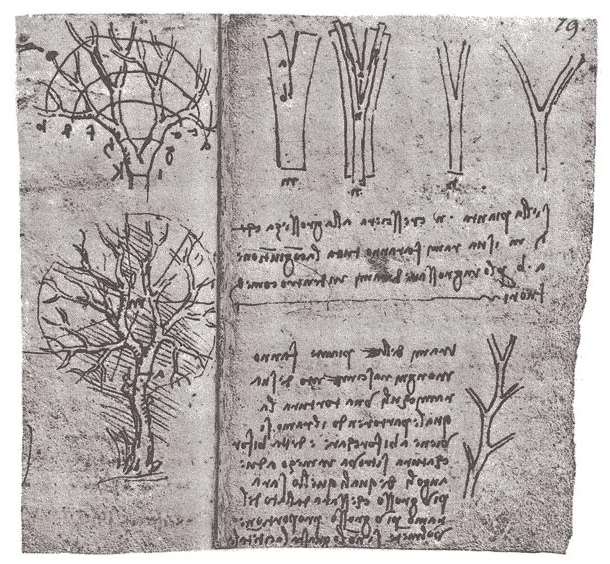

Leonardo da Vinci, Creative Commons
https://medium.com/the-istanbul-chronicle/how-do-trees-grow-42489c244be2
Branching Beyond Leonardo: The Evolution of Tree Architecture Theory
By Gayil Nalls
Sign up for our monthly newsletter!
Y ears ago, I traveled to Amboise, to the Château of Clos Lucé in France’s Loire Valley, where Leonardo da Vinci, the Renaissance polymath artist, architect, mathematician, biologist, physicist, and aeronaut, spent his final years. In 1516, he accepted King Francis I’s invitation to settle there and work on a variety of projects. Da Vinci died in 1519 at age 67, in the very room where I stood, gazing at the bed in which he passed. The room opened up to gardens and grounds filled with towering trees. I stood there, looking up into their expansive canopy.
Da Vinci’s curiosity about the natural world was boundless. Among the many subjects in his notebooks were his observations on tree growth, which continue to intrigue scientists and artists to this day. “All the branches of a tree at every stage of its height, when put together, are equal in thickness to the trunk. All the branches of water at every stage of its course, if they are of equal rapidity, are equal to the body of the mainstream,” he wrote.
Da Vinci had brought these notebooks, his codices, with him to France, where they documented his profound observations about art, science, and nature. His insights into the branching patterns of trees in particular have fascinated researchers for centuries. His “tree branching rule” proposed that the total cross-sectional area of a tree’s branches at any given height is equal to the area of the trunk. This observation helped Da Vinci draw realistic trees in his landscapes and hinted at a fundamental balance in nature—one that suggests the flow of nutrients and sap is distributed efficiently through the trunk and branches.
For centuries, this principle was accepted as a guide, not only for artists but also for those studying the natural world. Da Vinci’s rule implied a form of hydraulic balance, ensuring the tree’s efficient growth and resource distribution. It also anticipated the concept of fractals, recurring patterns in nature that promote both structural integrity and efficiency. His observations laid the groundwork for future studies in botany and mathematics, offering a qualitative yet strikingly accurate depiction of the harmony in tree growth.
Geoffrey West, in his book Scale: The Universal Laws of Growth, Innovation, and the Pace of Life in Organisms, Cities, Economies, and Companies, marvels at Da Vinci’s remarkable insight into nature’s branching systems. He says that Da Vinci understood that the area-preserving branching observed in the human circulatory system mirrors the fiber bundle structure in vascular plants and trees. The notebook page (displayed at the top of this article) illustrates da Vinci’s description of this principle, specifically the area-preserving branching patterns of trees. West highlights how extraordinary it is that Da Vinci made such profound observations about these universal laws of growth centuries before modern science fully explored them.
However, in April 2022, researchers published a new study in Physical Review E that questioned Da Vinci’s rule, revealing it does not apply to many types of trees. While his observations were groundbreaking, they did not account for factors like branch length, which significantly affect the growth patterns of different species. These researchers introduced a more nuanced model of tree branching, which they termed “Leonardo-like.” This new rule accounts for both branch thickness and length, providing a more accurate representation of how leafy trees grow.
Da Vinci’s rule suggested an elegant simplicity in tree mechanics, focusing on the conservation of the cross-sectional area and fluid dynamics within the tree. But the modern understanding, advanced by physicist Sergey Grigoriev and his team at the Petersburg Nuclear Physics Institute, proposes that tree branching is governed by more complex factors, including mechanical stability and hydraulic efficiency. These considerations better explain how trees distribute resources while maintaining the structural integrity needed to withstand environmental pressures like wind and gravity.
Grigoriev’s team introduced an additional concept, emphasizing the role of branch length and other variables that Da Vinci did not address. Their model introduces an exponent that varies based on species and environmental factors, accounting for the diversity in tree shapes and growth patterns seen in nature. This exponent reflects a compromise between the tree’s need for mechanical stability and its hydraulic conductivity—essentially balancing strength with efficient resource transport.
The implications of this new understanding reach far beyond theoretical studies of tree growth. These insights can help predict how trees respond to environmental challenges such as drought, disease, and climate change in ecology and forestry. Grigoriev’s work can inform better forest management practices, ensuring the health and sustainability of forests in an increasingly unpredictable climate.
Additionally, these findings have practical applications in biomimetics, where nature’s designs inspire human engineering. The branching patterns of trees, with their perfect balance between strength and efficiency, could guide the development of resilient structures like buildings, bridges, and even medical devices that mimic the efficiency of vascular systems. Understanding the dynamics of tree branching offers new ways to create systems that optimize both stability and fluidity—lessons we can apply across diverse fields.
Da Vinci’s observations were revolutionary for his time and remain a testament to his genius. His tree-branching rule inspired centuries of scientific inquiry and artistic representation. Now, as we deepen our understanding of these natural systems with new tools and knowledge, we build upon his foundation. The work of Grigoriev and his colleagues reflects a more detailed view of the natural world, one that embraces the complexity of tree growth while retaining the elegance Da Vinci first observed. Together, these insights offer a deeper appreciation for nature’s designs and the many ways they can inspire innovation in science, engineering, and environmental conservation and stewardship.
Gayil Nalls, Ph.D., is an interdisciplinary artist, the creator of World Sensorium, and the founder of the World Sensorium/Conservancy.
References
S. V. Grigoriev, et al. Experimental evidence for logarithmic fractal structure of botanical trees, Phys. Rev. E 105, 044412 – Published 29 April 2022
https://journals.aps.org/pre/abstract/10.1103/PhysRevE.105.044412
https://www.sciencenews.org/article/leonardo-da-vinci-rule-tree-branch-wrong-limb-area-thickness
West, Geoffrey. Scale, p. 121, Penguin Press. 2017
Plantings
Issue 41 – November 2024
Also in this issue:

The Healing Instinct: Plants, Animal Behavior, and the Origins of Medicine
By Gayil Nalls

Will Plants Grow on the Moon?
By Tom Metcalfe

The Art of the Brew: Exploring Beer’s Aromas, Flavors, and Sustainability
By Gayil Nalls

How Can We Make A Better Concrete Jungle
By Gayil Nalls

Cementing Change: How Ginger Dosier’s Biomason is Paving a Greener Path
By Erum Azeez Khan

Eat More Plants Recipes:
Vegetable Tian
By Chef Romain Delacretaz, Table Marine, Nice, France

As Ireland transitions from the rich, smoky scent of peat-burning to a more sustainable future, its olfactory heritage is evolving. What will become the next iconic aromatic symbol of Ireland?
Click to watch the documentary trailer.

